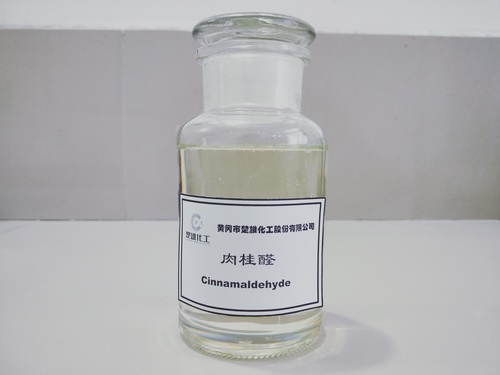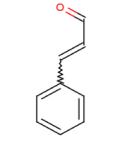Products
Position: Home > Products

| Overview | Cinnamaldehyde is commonly referred to as cinnamaldehyde, and naturally exists in Sri Lankan cinnamon oil, cinnamon oil, ageratum oil, hyacinth oil and rose oil and other essential oils. Cinnamic aldehyde has two isomers, cis and trans. The commercially available cinnamic aldehydes, whether natural or synthetic, are all trans isomers. |
| Basic Information |
Chinese name Cinnamic aldehyde
|
| Physical and chemical parameters | Purity: ≥99% Density: 1.046-1.052 |
| Refractive index (20℃): 1.619-1.623 | |
| Specific gravity (25/25℃): 1.046-1.050 | |
| Acid value: ≤1.0% | |
| Appearance: colorless or light yellow liquid. | |
| Aroma: strong aroma of cinnamon oil and cinnamon oil, mild spicy aroma, no spicy taste, strong and lasting aroma. Cinnamic aldehyde has a stronger aroma than cinnamyl alcohol. | |
| Solubility: hardly soluble in water and glycerin, easily soluble in alcohol, ether and petroleum ether. Can volatilize with water vapor. | |
| Stability: It is unstable in strong acid or strong alkaline medium, it is easy to cause discoloration, and it is easy to oxidize in the air. | |
| Storage and transportation conditions | The warehouse is low temperature, ventilated, and dry; fireproof; stored separately from oxidants and food materials. |
| Product Usage | One. The application of cinnamaldehyde in medicine |
| 1. Sterilization, disinfection and antisepsis, especially for fungi. | |
| 2. Anti-ulcer, strengthen stomach and intestinal movement. | |
| 3. Fat decomposition. | |
| 4. Antiviral effect. | |
| 5. Expand blood vessels and lower blood pressure. | |
| 6. Commonly used in external medicine and synthetic medicine. | |
| two. Application of Cinnamaldehyde in Chemical Industry | |
| 1. Organic chemical synthesis. Used to synthesize α-bromocinnamaldehyde, cinnamic acid, cinnamyl alcohol, cinnamonitrile and other products. | |
| 2. In industry, it can also be made into color reagent and experimental reagent. | |
| 3. Insecticide, mosquito repellent, refrigerator deodorant, preservative, etc. | |
| three. Application in flavors and fragrances | |
| Cinnamic aldehyde, as a hydroxy acid fragrance compound, has a good fragrance retention effect. It is used as a raw material for fragrance blending to make the aroma of the main spice more delicate. Because its boiling point is higher than other organic substances with similar molecular structure, it is often used as a fixative. It is commonly used in soap flavors to prepare flavors such as gardenia, frangipani, lily of the valley, rose, etc., and can be used in apple, cherry, and fruit flavors in food flavors. | |
| four. Application in feed | |
| Cinnamaldehyde is different from general growth promoters. It can indeed increase the amount of nitrogen stored in the animal's body in the feed (about 7%). Nitrogen is the main component for the synthesis of animal muscle cells, so it can improve the quality of carcass Positive impact. | |
| Fives. Application in anti-corrosion | |
| After the betel nut is soaked in the cinnamaldehyde solution, it can be sold in the open air without any packaging and will not deteriorate for a long time. As a preservative, cinnamaldehyde can not only greatly extend the shelf life, but also degrade into the nutrients needed by the human body after entering the human body, which is harmless and beneficial to the human body. Cinnamaldehyde can not only enhance the medicinal effect of betel nut, make betel nut more pure, its unique cinnamon fragrance, but also enhance the taste and taste of betel nut. | |
| Remarks | The company also produces cinnamaldehyde series products: cinnamic acid, cinnamaldehyde, cinnamyl alcohol, methyl cinnamate, ethyl cinnamate and other cinnamon series, which can meet the requirements of various indicators. |





